Societe Pour L'Aviation et ses Derives - Picture
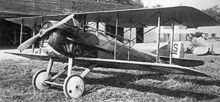
|
|
Societe Pour L'Aviation et ses Derives

Picture - SPAD S.VII
SPAD was a French aircraft manufacturer between 1911 and 1921. Its SPAD S.XIII biplane was the most popular French fighter airplane in World War I.
Deperdussin
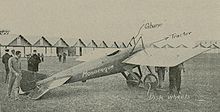
Picture - An early version of the Deperdussin Monocoque.
The company was set up in 1911 as Aéroplanes Deperdussin, becoming the Société de Production des Aéroplanes Deperdussin in 1912. Founder Armand Deperdussin (1867-1924) had been a travelling salesman and a cabaret singer in Lix¨ge and Brussels, before making his fortune in the silk business. Deperdussin became fascinated by aviation in 1908, and in 1909 he established an aircraft works at Laon. Deperdussin himself was not a noted designer, but he hired the talented engineer Louis Béchereau (1880-1970) as technical director. Béchereau would be responsible for Deperdussin and SPAD aircraft designs thereafter.
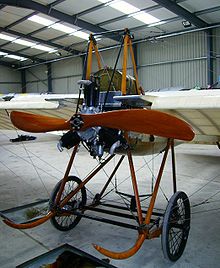
Picture - 1910 Deperdussin monoplane replica at the Shuttleworth Collection
The first SPAD aircraft built in any quantity were the Deperdussin Monocoque and the Deperdussin TT. Both were mid-wing braced monoplanes, similar to Louis Blériot's Blériot XI, and the Nieuport 4, a layout popular with military and civilian clients in the period before the First World War. The TT was a considerable export success, and 63 were built by the Lebedev company in Russia. The model was purchased in small numbers by foreign clients from Deperdussin, and built at Highgate, England by the British Deperdussin Company, run by D Lawrence Santoni and John Cyril Porte. From 1911 Deperdussin was producing his aircraft from a new facility at Grenelle, in the Paris suburbs.
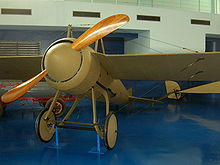
Picture - The Deperdussin Monocoque preserved at the Musée de l'Air et de l'Espace.
They also created factories at Le Havre and Juvisy to build motor boats and waterplanes. The first Schneider Trophy competition was run on 16 April 1913, at Monaco and won by a Deperdussin floatplane at an average speed of 45.75 mph (about 73 km/h). Deperdussin "Monocoques" won the 1912 and 1913 Gordon Bennett Trophy races, set several world speed records and were the first airplanes to exceed 200 km/h.
In 1913, Armand Deperdussin was arrested on charges of fraud. He had developed expensive tastes, and, in addition to funding competitions such as the Gordon Bennett Cup, he entertained lavishly. The trading arm of the Comptoir Industrial et Colonial claimed that he funded this by fraudulently borrowing from them using forged receipts from his silk business as security. He remained incarcerated until he was brought to trial in 1917. Although it was claimed that he used much of the money to develop France's aviation expertise, he was convicted and sentenced to five years in prison, but as a concession for first offenders he was reprieved ("sursis") and released immediately. Deperdussin never recovered from the incident and committed suicide in 1924.
Béchereau
After Armand Deperdussin's bankruptcy in 1913 the company went into administration and the name was changed to Société Provisoire des Aéroplanes Deperdussin. With Deperdussin's disgrace the cash flow stopped and the future of the SPAD company was endangered. A consortium led by Louis Blériot bought up the company's assets in 1913 and appointed Béchereau to run the business. The new entity, known as the Société Pour L'Aviation et ses Dérivés, was better known as SPAD.
The first Béchereau-SPAD designs were unusual two-seat biplanes which attempted to provide a forward-firing machine gun in a tractor configuration aircraft. The pilot sat behind the airscrew, as in a tractor design, but the gunner was seated in a nacelle, or pulpit, in front of the propeller, attached to the landing gear. These designs, the SPAD A-series of models A.1, A.2 A.3, and A.4, were built in very small numbers, around sixty each for French and Russian air forces, and were neither popular nor successful. The subsequent development of an effective interrupter gear rendered the unusual configuration unnecessary.
Other early Béchereau designs were generally unsuccessful. The SE, a large twin-engine biplane bomber, performed well on trials, but it was not ordered due to the greater promise of Béchereau's next design.
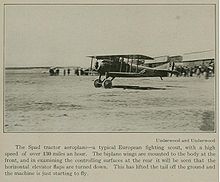
Picture - A SPAD plane taking off
Béchereau's first real success was the SPAD S.VII, which superficially resembled a smaller, neater A.2 - without the forward gunner's nacelle. Developed from the SPAD V, of which 268 were ordered but none certainly built as SPAD Vs, the SPAD S.VII was a single-seat tractor biplane fighter of simple and robust design powered by the new Hispano-Suiza water-cooled V-8 engine. Compared to earlier fighters, when the SPAD VII appeared in 1916, it seemed a heavy and unmanoeuvrable aircraft, but pilots soon learned to take advantage of its speed and strength. Some 3,500 SPAD S.VIIs were built in France during the First World War, 120 in Britain, and 100 in Russia, although far more had been ordered from a new factory in Yaroslavl which was not completed until after the Russian Civil War.
Béchereau's subsequent designs until 1918 followed the basic outline of the SPAD S.VII. The two-seaters, the SPAD XI and SPAD XVI, were built in moderate numbers, around 1,000 of each type, but two-seater SPADs were much less successful than the rival Breguet 14 (5,500 built) and Salmson 2 (3,200 built). Single-seat developments of the SPAD 7 were more successful. The SPAD XII was a minor variant, the first to use the geared output Hispano-Suiza V-8 engine, which allowed it to be armed with a 37 mm Hotchkiss cannon (moteur-canon) firing through the propeller hub. Tested successfully by ace Georges Guynemer, the general conclusion on the SPAD XII is that only very skillful pilots could exploit its powerful armament. Accordingly, although 300 were ordered, most were completed as normal SPAD fighters, with possibly one or two of the SPAD XII aircraft even serving with the US Air Service in France.
The SPAD S.XIII was essentially the SPAD S.VII redesigned around a more powerful, geared drive Hispano-Suiza engine, as was used on the SPAD XII. This was produced in even greater numbers, the exact total is uncertain with figures from 7,300 to 8,472 being quoted in different sources. Single-seat SPADs were flown by many ace pilots, including Italy's Count Francesco Baracca and the United States Army Air Service's Capt. Eddie Rickenbacker, with 34 and 26 victories respectively. Georges Guynemer was, as has already been noted, highly successful with the SPAD S.XII, as well as the SPAD S.VII and SPAD S.XIII. At the end of the First World War, all 1,152 single-seat fighters on the strength of French front line air units were SPAD 13s. It is reported that nearly 900 SPAD XIII fighters were eventually to end up in American service.
Although SPAD had been successful, and had reaped very large profits, the very high profits in aircraft manufacturing had led to increased competition during the war. In 1916, for example, over 98% of the SPAD fighters built had come from factories owned by SPAD and Blériot. By 1918, with large industrial syndicates competing for contracts, this had fallen to 43%. SPAD designs accounted for around 20% of French aircraft produced during World War One. Louis Blériot's 1913 investment was a very profitable one.
Blériot-SPAD
Post-war the company became Blériot-SPAD. The first of its designs to be known by this name was Bécherau's elegant monocoque SPAD 20 biplane. First flown in 1918, the SPAD 20 was not delivered until 1920. The return of peace meant orders were small; only 93 were built.
The return of peace also meant that the company had to face the problem of dealing with its liabilities under the excess profits tax of 1 July 1916. As modified in 1917, this imposed an 80% tax rate on almost all "excess profits". The calculation and collection of the tax was a controversial issue, and very large amounts were still outstanding as late as 1940, when the German occupation rendered the whole question irrelevant. With the future uncertain, SPAD was fully incorporated into the Blériot organisation in 1921, and the company effectively disappeared, although a number of Blériot types were marked as SPADs.
Aircraft
Deperdussin Monocoque
Deperdussin TT
SPAD A.2
SPAD S.VII
SPAD S.XI
SPAD S.XII
SPAD S.XIII
SPAD S.XIV
SPAD S.XX
Bleriot-SPAD S.33
Bleriot-SPAD S.34
Bleriot-SPAD S.46
Bleriot-SPAD S.51
Bleriot-SPAD S.61
Bleriot-SPAD S.66
Bleriot-SPAD S.81
Bleriot-SPAD S.510
Davilla, James M. & Arthur M. Soltan, French Aircraft of the First World War. Flying Machines Press, Stratfort, Connecticut, 1997. ISBN 0-9637110-4-0
Societe Pour L'Aviation et ses Derives Pictures and Societe Pour L'Aviation et ses Derives for Sale.
Living Warbirds: The best warbirds DVD series.
Source: WikiPedia